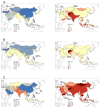Burden and Trends of Acute Viral Hepatitis in Asia from 1990 to 2019
- PMID: 35746650
- PMCID: PMC9227073
- DOI: 10.3390/v14061180
Burden and Trends of Acute Viral Hepatitis in Asia from 1990 to 2019
Abstract
Asia has a very high burden of acute hepatitis; thus, a comprehensive study of the current burden and long-term trends of acute hepatitis in Asia is needed. We aimed to assess the current status and trends from 1990 to 2019 of acute hepatitis burden in Asia, using the data from the Global Burden of Diseases Study 2019 (GBD 2019) results. Methods: We used the data from the GBD 2019. Absolute death, incidence, and disability adjusted life years (DALY) number and rate of acute hepatitis in Asia were derived from the database from 1990 to 2019. Age-standardized mortality, incidence and DALY rates (ASMR, ASIR and ASDR) were used to compare populations in different regions and times. The estimated annual percentage change (EAPC) in the rates quantified the trends of the acute hepatitis burden. Results: From 1990 to 2019, the ASMR and ASDR of acute hepatitis decreased significantly at different paces, with the largest decrease in acute hepatitis C and the smallest in acute hepatitis E. The ASIR of acute hepatitis decreased relatively slowly, by an average of 0.06% (95% CI, 0.05-0.08%) per year in acute hepatitis A, 0.91% (0.64-1.18%) per year in acute hepatitis C and 0.26% (0.24-0.28%) per year in acute hepatitis E; while the ASIR of acute hepatitis B decreased by an average of 1.95% (1.08-2.11) per year. From 1990 to 2019, the incidence rate of acute hepatitis A increased in most age groups (from the age of 5 to 70), with the 50-55 years group having the fastest increase by an average of 1.81% (95% CI, 1.67-1.95%) per year. In 2019, Afghanistan had the highest ASMR (10.44 per 100,000) and ASDR (357.85 per 100,000) of acute hepatitis, and the highest ASIR was in Mongolia (4703.14 per 100,000). Conclusions: In Asia, the burden of acute viral hepatitis was at a relatively high level, compared with the other four continents. International cooperation and multifaceted and multisectoral actions are needed for Asian countries to eliminate viral hepatitis and to contribute to the global elimination of viral hepatitis.
Keywords: Asia; acute viral hepatitis; burden; trends.
Conflict of interest statement
The authors declare no conflict of interest.
Figures





Similar articles
-
Disparities in the global burden of tracheal, bronchus, and lung cancer from 1990 to 2019.Chin Med J Pulm Crit Care Med. 2023 Mar 28;1(1):36-45. doi: 10.1016/j.pccm.2023.02.001. eCollection 2023 Mar. Chin Med J Pulm Crit Care Med. 2023. PMID: 39170872 Free PMC article.
-
Burden of acute hepatitis E virus in South Asia: Insights from Global Burden of Disease study 2021.Diagn Microbiol Infect Dis. 2025 Jul;112(3):116767. doi: 10.1016/j.diagmicrobio.2025.116767. Epub 2025 Mar 8. Diagn Microbiol Infect Dis. 2025. PMID: 40107226
-
Temporal trends of tracheal, bronchus, and lung cancer between 2010 and 2019, in Asian countries by geographical region and sociodemographic index, comparison with global data.Thorac Cancer. 2023 Jun;14(18):1668-1706. doi: 10.1111/1759-7714.14912. Epub 2023 May 1. Thorac Cancer. 2023. PMID: 37127553 Free PMC article.
-
Global Patterns and Trends in Total Burden of Hepatitis B from 1990 to 2019 and Predictions to 2030.Clin Epidemiol. 2022 Dec 14;14:1519-1533. doi: 10.2147/CLEP.S389853. eCollection 2022. Clin Epidemiol. 2022. PMID: 36540899 Free PMC article.
-
The global burden of hemorrhagic stroke: a summary of findings from the GBD 2010 study.Glob Heart. 2014 Mar;9(1):101-6. doi: 10.1016/j.gheart.2014.01.003. Glob Heart. 2014. PMID: 25432119 Review.
Cited by
-
Incidence and Mortality Trends of Upper Respiratory Infections in China and Other Asian Countries from 1990 to 2019.Viruses. 2022 Nov 18;14(11):2550. doi: 10.3390/v14112550. Viruses. 2022. PMID: 36423159 Free PMC article.
-
Pancreatic cancer challenge in 52 Asian countries: age-centric insights and the role of modifiable risk factors (1990-2019).Front Oncol. 2023 Oct 2;13:1271370. doi: 10.3389/fonc.2023.1271370. eCollection 2023. Front Oncol. 2023. PMID: 37849795 Free PMC article.
-
Knowledge and awareness of viral hepatitis and influencing factors among the general population aged 15-69 years in Zhejiang Province, China.Hum Vaccin Immunother. 2023 Aug 1;19(2):2252241. doi: 10.1080/21645515.2023.2252241. Hum Vaccin Immunother. 2023. PMID: 37706316 Free PMC article.
-
A cost-effective predictive tool for AFP-negative focal hepatic lesions of retrospective study: enhancing clinical triage and decision-making.PeerJ. 2025 Mar 26;13:e19150. doi: 10.7717/peerj.19150. eCollection 2025. PeerJ. 2025. PMID: 40161339 Free PMC article.
-
Evolving Trends and Burden of Inflammatory Bowel Disease in Asia, 1990-2019: A Comprehensive Analysis Based on the Global Burden of Disease Study.J Epidemiol Glob Health. 2023 Dec;13(4):725-739. doi: 10.1007/s44197-023-00145-w. Epub 2023 Sep 1. J Epidemiol Glob Health. 2023. PMID: 37653213 Free PMC article.
References
-
- World Health Organization Fact-Sheet: Hepatitis. 2022. [(accessed on 10 April 2022)]. Available online: https://www.who.int/health-topics/hepatitis#tab=tab_1.
-
- World Health Organization Global Hepatitis Report, 2017. 2017. [(accessed on 10 April 2022)]. Available online: https://www.who.int/publications-detail-redirect/9789241565455.
-
- James S.L., Abate D., Abate K.H., Abay S.M., Abbafati C., Abbasi N., Abbastabar N., Abd-Allah F., Abdela J., Abdelalim A., et al. Global, regional, and national incidence, prevalence, and years lived with disability for 354 diseases and injuries for 195 countries and territories, 1990–2017: A systematic analysis for the Global Burden of Disease Study 2017. Lancet. 2018;392:1789–1858. doi: 10.1016/S0140-6736(18)32279-7. - DOI - PMC - PubMed
Publication types
MeSH terms
LinkOut - more resources
Full Text Sources
Medical

